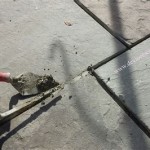Do You Need To Seal a Cement Patio?
Cement patios offer a durable and versatile outdoor living space. However, the question of whether to seal a cement patio is a common one among homeowners. Sealing can offer several benefits, but it also involves costs and potential drawbacks. Understanding the properties of cement, the environmental factors that impact it, and the types of sealers available is crucial for making an informed decision about whether sealing is necessary for a specific patio.
The primary concern regarding unsealed cement patios is their porous nature. Cement, by its inherent composition, contains microscopic pores that allow water and other substances to penetrate. This porosity makes the patio susceptible to staining, cracking, and overall deterioration over time. While some homeowners opt to leave their cement patios unsealed, appreciating the natural look of the material, this approach carries inherent risks. Regular cleaning can mitigate some of the staining, but it doesn't address the underlying problem of water absorption and potential freeze-thaw damage in colder climates.
The lifespan of a cement patio hinges on several factors, including the quality of the initial concrete mix, the proper installation techniques employed, and the environmental conditions it endures. A well-constructed patio made with a high-quality mix will naturally be more resistant to damage than one built with substandard materials. Proper drainage is also crucial, as standing water exacerbates the problems associated with moisture penetration. However, even with optimal construction, the porous nature of cement remains a potential vulnerability, particularly in regions with harsh winters or frequent rainfall.
Understanding the Benefits of Sealing a Cement Patio
Sealing a cement patio offers a range of advantages related to durability, aesthetics, and maintenance. By creating a protective barrier, sealers minimize the ingress of water, oils, and other staining agents, extending the lifespan of the patio and preserving its appearance. While the initial cost of sealing represents an investment, the long-term benefits often outweigh the expense, particularly in environments where the patio is exposed to harsh weather or heavy use.
One of the primary benefits of sealing is
enhanced protection against water damage
. Water that penetrates the cement can lead to cracking and spalling, especially in regions subject to freeze-thaw cycles. When water freezes within the pores of the cement, it expands, exerting pressure that can weaken the material and eventually cause it to crumble. A sealer effectively prevents water from entering these pores, mitigating the risk of freeze-thaw damage and prolonging the life of the patio. This is particularly important in areas with cold winters where temperatures frequently fluctuate around the freezing point.Another significant advantage is
stain resistance
. Unsealed cement is highly susceptible to staining from a variety of sources, including spilled food and drinks, oil from vehicles, and leaf tannins. These stains can be difficult or impossible to remove, detracting from the patio's aesthetic appeal. A sealer creates a barrier that repels these substances, making it easier to clean spills and maintain the patio's pristine appearance. This benefit is especially valuable for patios used for outdoor dining or entertaining.Furthermore, sealing can
improve the overall appearance of the patio
. Certain sealers enhance the color and texture of the cement, giving it a richer, more vibrant look. Some products create a glossy finish, while others offer a more matte appearance, allowing homeowners to customize the patio's aesthetic to their preference. Beyond purely aesthetic benefits, the improved appearance can increase property value and enhance the enjoyment of the outdoor space.Finally, a sealed cement patio is
easier to clean and maintain
. The protective barrier created by the sealer prevents dirt and grime from penetrating the pores of the cement, making routine cleaning more efficient. Regular sweeping and occasional washing with a mild detergent are often sufficient to keep a sealed patio looking its best. This reduced maintenance requirement saves time and effort for homeowners, allowing them to enjoy their outdoor space without the burden of extensive upkeep.Types of Cement Patio Sealers
The market offers a variety of cement patio sealers, each possessing distinct characteristics and benefits. Selecting the appropriate sealer requires careful consideration of factors such as the type of cement, the desired finish, the level of protection required, and the ease of application. Common categories of sealers include acrylic sealers, penetrating sealers, and epoxy sealers, each suited to different needs and applications.
Acrylic sealers
are a popular choice for their ease of application and relatively low cost. They form a protective film on the surface of the cement, providing a good level of stain resistance and water repellency. Acrylic sealers are available in both water-based and solvent-based formulations, with water-based options being generally considered more environmentally friendly. However, acrylic sealers are typically less durable than other types of sealers and may require more frequent reapplication, usually every one to three years. They are a good option for homeowners seeking an affordable and easy-to-apply sealer with moderate protection.Penetrating sealers
work by penetrating the pores of the cement and creating a chemical bond that repels water and other liquids. These sealers do not form a surface film, so they do not alter the appearance of the cement. Penetrating sealers are particularly effective at preventing freeze-thaw damage because they prevent water from entering the pores in the first place. Siloxane and silane sealers are common types of penetrating sealers. They offer excellent durability and can last for several years before requiring reapplication. Penetrating sealers are a good choice for homeowners who prioritize long-lasting protection and want to maintain the natural look of the cement.Epoxy sealers
provide the highest level of protection and durability. They form a thick, resilient coating that is resistant to stains, chemicals, and abrasion. Epoxy sealers are often used in high-traffic areas or in environments where the patio is exposed to harsh conditions. They are available in a variety of colors and finishes, allowing for customization of the patio's appearance. However, epoxy sealers are typically more expensive and require more skill to apply than other types of sealers. They are a good option for homeowners who need maximum protection and are willing to invest in a professional application.In addition to these main types,
polyurethane sealers
are also available. These offer a good balance of durability and flexibility, making them resistant to cracking and chipping. Polyurethane sealers are often used as a topcoat over epoxy sealers to provide added protection against abrasion and UV damage.Choosing the right sealer also depends on whether the cement is stamped or colored. Some sealers can enhance the color of stamped cement, while others are specifically designed to protect colored cement from fading. Always read the manufacturer's instructions carefully before applying any sealer to ensure compatibility with the cement type and desired finish.
Factors to Consider Before Sealing
Before embarking on the sealing process, several factors should be carefully evaluated to determine whether sealing is truly necessary and to ensure optimal results. These considerations include the age and condition of the cement, the climate in which the patio is located, the intended use of the patio, and any existing coatings or treatments on the cement surface. Ignoring these factors can lead to ineffective sealing or even damage to the patio.
The
age and condition of the cement
are critical factors. New cement should typically be allowed to cure for at least 30 days before sealing to allow excess moisture to evaporate. Sealing cement that is not fully cured can trap moisture, leading to efflorescence (a white, powdery deposit on the surface) or other problems. Existing cement should be thoroughly cleaned and inspected for cracks or other damage before sealing. Cracks should be repaired prior to sealing, as the sealer will not bridge gaps and may even exacerbate the problem.The
climate
plays a significant role in determining the necessity of sealing. Patios in regions with harsh winters or frequent rainfall are more susceptible to water damage and should generally be sealed to protect against freeze-thaw cycles and water penetration. In drier climates, sealing may be less critical, but it can still provide benefits in terms of stain resistance and ease of maintenance. Consider the average rainfall, temperature fluctuations, and UV exposure in the area when deciding whether to seal.The
intended use of the patio
should also be considered. Patios used for outdoor dining or entertaining are more likely to be exposed to spills and stains, making sealing a worthwhile investment. Patios used primarily for relaxation or as a walkway may not require sealing as urgently. Also consider the type of furniture that will be used on the patio. Heavy furniture can scratch or damage unsealed cement, making sealing a desirable option.Finally,
any existing coatings or treatments
on the cement surface must be taken into account. If the cement has previously been sealed, it may be necessary to remove the old sealer before applying a new coat. Applying a new sealer over an existing one can lead to poor adhesion and peeling. The type of existing sealer will also influence the choice of new sealer. Some sealers are not compatible with others and can cause discoloration or other problems. If the cement has been treated with a water repellent or hardener, it may be necessary to consult with a professional to determine the best sealing approach.Proper preparation is essential for successful sealing. The cement surface should be thoroughly cleaned to remove dirt, grime, and any loose debris. Pressure washing is an effective method for cleaning cement patios, but care should be taken not to damage the surface. Any stains should be treated with a suitable cleaning agent before sealing. Once the cement is clean and dry, the sealer can be applied according to the manufacturer's instructions. Follow all safety precautions and wear appropriate protective gear, such as gloves and eye protection.

Why You Should Seal Your Concrete Driveway Or Patio Gleam Team

How To Seal Your Concrete Patio A Comprehensive Diy Guide Liquid Rubber

7 Steps To Sealing Concrete Like A Pro Expert How Guide Network

Concrete Patio Sealer Gatorguard

Penetrating Vs Surface Concrete Sealers Which Is Best

Should You Seal Patios Other Hardscaping Before Winter Bay Landscaping

How Much Does Concrete Sealing Cost Guide

How To Seal A Concrete Patio Once U C Coatings

How To Re Seal A Stained Concrete Patio

Muncie Concrete Sealing Experts
Related Posts








